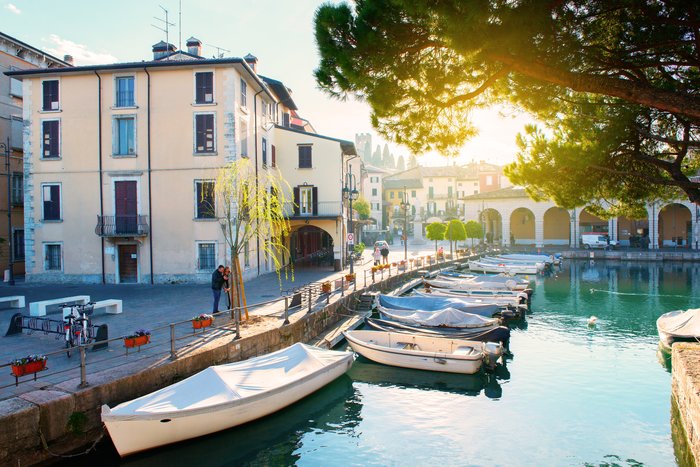Discover the Mysterious Underground of Naples, Naples
Overview
Naples has a lot to offer if you enjoy exploring crypts, catacombs, tunnels, and hidden passages! The city is famous for the magnificent seaside, Mount Vesuvius, an ancient Roman old town, and a mysterious underground covering nearly 500 acres. Today, it’s possible to visit parts of this underground area, discovering a Greek-Roman aqueduct, a Greek-Roman theater, the Hypogeum Gardens, and the Summa Cavea.
There are still more sites to see, including the Bourbon Tunnel, a hidden military passage and masterpiece of civil engineering, and centuries-old burial sites. The Fontanelle Cemetery sits within a cave on the hillside of the Materdei district. It became part of the Neapolitan folklore and pagan rituals. The Catacombs of San Gennaro and San Gaudioso are living proof of the first Christian communities in the city and reveal the bond of faith between the town and its saints.
You can reach Naples' underground, known as Napoli Sotterranea, on foot from the historic center. The entrance is in the city's heart, in the left corner of Piazza San Gaetano if you are coming from Via Duomo or San Gregorio Armeno. Blue and white flags highlight the entrance.
Recommended Schedule:
-
The Greek-Roman Aqueduct: After descending 136 relatively comfortable steps, you'll be about 120 feet (40 m) underground and ready to step back in time! The aqueduct is spacious and illuminated, except for a short segment where you can join an optional tour with a guide for one hour. You'll also visit the air-raid shelters from the Second World War, the War Museum, and the Hypogeum Gardens.
-
The Greek-Roman Theater: Inside a typical underground house, you'll open a hatch underneath the bed to access the remains of an ancient theater. This is where Emperor Nero also had his private dressing room whenever he performed his shows in Naples. The tour lasts about 20 minutes.
-
Summa Cavea: Another part of the Roman Theater is located in an old carpentry site, where you'll find a permanent exhibition of “Scarabattoli” behind glass to preserve the religious nativity scene. Inside the new fragment of the theater, archeologists discovered small running water channels that acted as drain sewers from the Bourbon period, made out of blue patterned tiles.
-
The Bourbon Tunnel: The Bourbon Tunnel is a majestic underground civil engineering masterpiece dating back to the 14th century. Designed by the great architect Enrico Alvino, it acted as a secret royal passage for King Ferdinand II of Bourbon. Together with this hidden military passage, you can also visit part of the Renaissance aqueduct system, World War II air bomb shelters built in these underground spaces to protect the city inhabitants, and vintage cars and motorbikes from the 50s.
-
Fontanelle Cemetery: The Fontanelle Cemetery in Naples is a graveyard located within a hillside cave of the Materdei district. It dates back to the Spanish domination of the 16th century when graves were built outside the city walls. In 1656 CE, the city buried thousands of anonymous corpses (victims of the great plague) in the cemetery. The cave became the unofficial final resting place for the poor, many of whom couldn't afford to be buried in a regular cemetery. In the early 19th century, under the French rule of Naples, Fontanelle was finally recognized as an official cemetery.
-
Catacombs of San Gennaro & San Gaudioso: The most ancient part of the Catacombs of San Gennaro is a tomb of a noble family, dating back to the 2nd century CE. Its expansion continued when moving the mortal remains of the city’s most loved and popularly acclaimed patron, San Gennaro. Thus, Naples’ oldest and most sacred catacombs became a Christian pilgrimage and coveted place for burial.
These Catacombs are arranged on two levels offering much larger spaces than the more famous Rome catacombs. Under the Basilica of Santa Maria della Sanità, you can explore the second most important early Christian cemetery of the city, the Catacombs of San Gaudioso. Entrance to the Catacombs of San Gennare's is next to the Madre del Buon Consiglio Basilica.
Like what you see?
Chat with our local specialists and let us help you customize your trip with experiences like this.
Get startedLike what you see?
Chat with our local specialists and let us help you customize your trip with experiences like this.
Get startedItineraries with Discover the Mysterious Underground of Naples


Rome, Naples & the Amalfi Coast - 10 Days
Start off your trip in the heart of it all—Rome. Explore this capital city's ancient monuments and historic piazzas before making your way down the Italian peninsula to Naples....


Naples & the Amalfi Coast - 6 Days
Make the most of your time in Italy, exploring the vibrant city of Naples and soaking in the incomparable views of the Amalfi Coast. Start in bustling Naples, the birthplace of...

Discover Greek & Italian History: Athens, Crete, Venice, Rome, & Naples - 10 Days
If you have ten days to get away and want to dive into Mediterranean history from the Bronze Age to the Middle Ages, this itinerary combining Greece and Italy is for you. From...
Naples Experiences
Show more Naples experiences
Beach Day on the Amalfi Coast
The beaches along the Amalfi Coast are some of the most beautiful in Italy. As a result, many people choose to spend all or part of their trip on this small stretch of coastline...

Hiking Mt. Vesuvius from Naples
Discover the incredible landscape of Mount Vesuvius National Park and hike the famous volcano’s epic crater while enjoying the views of the Gulf of Naples. Learn about Pompeii...

Pompeii & Wine Tasting on Mt Vesuvius
This exciting and unique tour allows you to explore Pompeii, one of the best-preserved archaeological sites in the world, and hike the crater of the Mount Vesuvius volcano....

Sorrento Walking Tour
Sorrento is a long-time favorite with Italian and international visitors, thanks to its beautiful views, tranquil atmosphere, and terraced lemon groves. Explore its historic...

Interactive Pompeii Tour for Kids
Discover the incredible ancient ruins of Pompeii with your family in an entertaining and unique way! This kid-friendly exploration runs as an interactive, workshop-like...
Italy Experiences
Show more Italy experiences
Explore Local Beaches
The beaches along Sorrento’s southern coast are some of the most beautiful in Italy. As a result, many people choose to spend all or part of their trip on this small stretch of...

Early Morning Vatican Tour in Rome
Discover the museums of the Vatican City and the Sistine Chapel with an early-morning tour of the city's incredible art and history. By visiting the Vatican Museums early,...

Lake Garda with Kids & Teens
Lake Garda is the most family-friendly Italian lake. There are many activities to enjoy in amazing nature and a significant number of theme and water parks for everyone but...

Dog Sledding Excursion
Learn to mush a team of sled dogs on the slopes of the Julian Alps in Tarvisio, just over the Slovenia-Italy border, with the help of an experienced musher. After a briefing on...

Hiking the Path of Gods on the Amalfi Coast
Hike one of the most beautiful trails in Italy, the “Path of the Gods” on the Amalfi Coast. Enjoy the incredible panoramic views as you walk about 1,600 feet (500 m) above sea...
Best of Naples
Best of Naples
Best Things to Do in Naples
Naples is an eclectic mix of traditional Italian culture, authentic grit, and modern polish. It's loud, it's passionate, and it has a personality of its own. You'll arguably...

Top Culinary Experiences in Italy
Italy is a food haven with some of the world's favorite dishes, like the signature Neapolitan pizza, fresh pesto pasta from the Italian Riviera, lemon-infused delicacies of...

How Many Days to Spend on the Amalfi Coast
Around five days should be more than enough time to soak in the wonders of the Amalfi Coast, one of Italy's most beautiful destinations, but even if you have a day or three to...

Best Time of Year to Visit the Amalfi Coast
In southern Italy lies the Amalfi Coast, a 31-mile (50 km) stretch of coastline that's the very definition of Mediterannean beauty. Known for its sunkissed lemon groves, pebble...

Hidden Grottoes of the Amalfi Coast: 7 Secluded Beaches to Discover
For pure Mediterranean beauty, nothing beats Italy's Amalfi coast. The scenic drives and pebbly beaches are well known by this point, as are the romantic grottoes that dot the...
Trip Planning Essentials

How kimkim Trips Work in Italy
Italy is one of the most sought after destinations in the world for its history, romance, and (of course) incredible cuisine. Hit the classic stops or head off the beaten...

Ultimate Italy Itineraries: 5, 7, 10 & 14 Days
A trip to Italy should be well researched and painstakingly planned out: that's why we've done that part for you! Our local specialists and travelers told us what they love most...

Italy Travel Agents
Kimkim has selected the best Italy travel agents so you'll have a worry-free trip




